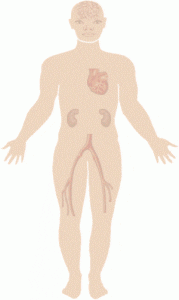 Researchers at York University have discovered a new protein that might hold the answer to the problem of controlling blood sugar and appetite.
Researchers at York University have discovered a new protein that might hold the answer to the problem of controlling blood sugar and appetite.
The protein is called nesfatin-1 and Suraj Unniappan, an associate professor in the York Department of Biology, Faculty of Science & Engineering, is exploring its characteristics. The protein occurs naturally in large amounts in the brain; Unniappan administered rats with the protein and found that they were more active and ate less while their metabolisms were more likely to use stored body fat to generate energy. The administration of the protein in rats and mice also stimulated pancreatic beta cells into secreting insulin.
“[The rats] actually ate more frequently but in lesser amounts,” said Unniappan, who was chosen by York’s neuroscience graduate diploma program and also received the Canadian Institutes of Health Research New Investigator Award. “In addition, they were more active and we found that their fatty acid oxidization was increased,” added Unniappan. “In other words, the energy reserve being preferably used during nesfatin-1 treatment was fat. This suggests more fat loss, which could eventually result in body weight loss.” The rats’ metabolisms switched to using fat as their preferred energy resource, making it more likely that body fat would be reduced through activity.
Unniappan’s findings were published in the form of two recent articles in Endocrinology and in the Journal of Endocrinology.
A research team from Japan discovered nesfatin-1 in 2006. It has been shown in the past that nesfatin-1 regulates appetite and the storage of body fat when it is injected into the brains of rats and mice.
Unniappan showed through his research that, in addition to regulating body fat, nesfatin-1 stimulates the islets of Langerhans in the pancreas into producing several hormones, including insulin. The pancreas then secretes the insulin into the bloodstream, which works to reduce blood sugar levels.
Unniappan’s research team had previously shown the link between nesfatin-1 and diabetes in mice. Not only could nesfatin-1 be used to stimulate the production of insulin in mice, but the islets of Langerhans in mice with Type 1 diabetes showed decreased nesfatin-1 production while those in mice with Type 2 diabetes displayed increased nesfatin-1 production. In patients with Type 1 diabetes, the destruction of pancreatic cells causes the body to stop producing insulin while Type 2 diabetes sees patients becoming insulin resistant.
Unniappan focuses his research on discovering and analyzing metabolic hormones on fish and mammals. “We call this the gut-brain axis,” he says. “While the brain is involved in many factors that regulate our energy balance, the gut is also responsible for many neural and endocrine signals responsible for regulating hunger, satiety and blood sugar levels. A major question we’re trying to address is how these peptides act and interact with other peptides in the endocrine network – which is so complex – in order to maintain steady blood glucose levels and body weight.”
Unniappan believes that understanding this gut-brain axis is the key to developing new medications and treatments for obesity and diabetes. However, he warns that nesfatin-1 may not be used pharmacologically any time soon. “New hormone-based treatments that would suppress body weight and blood sugar would be very desirable. However, we are far from developing nesfatin-1 as a candidate molecule. Our current research focuses on further exploring the therapeutic potential of nesfatin-1 in metabolic diseases with debilitating complications.”